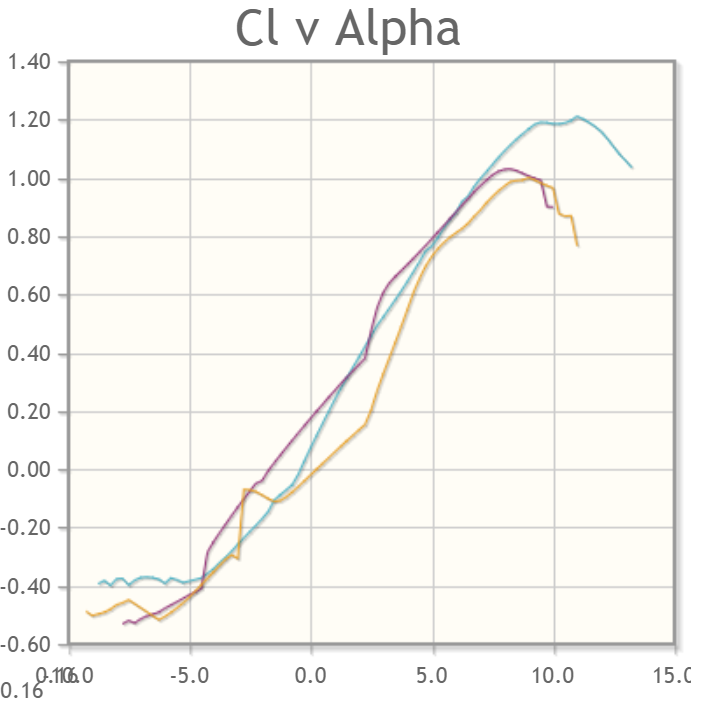The removable wiglets is not a bad idea. It'll make the wing more modular and potentially save a bit of hangar rash if you pick something fancy or low-slung for your final set. That and you seem to want practice building removable sections . . . that would do it

So I think you're missing the mix of what the Cl v Alpha chart is saying. For a given airspeed (in formal design the cruise speed is a design goal, in model building it tends to be more of a point of interest) you will need to attain a given Cl for the downward velocity to stay constant (Lift = Weight). For a given airspeed, this value depends more on your wing-loading than your airfoil selection. The Cl v Alpha chart tells you at what Alpha -- your AoA -- the wing will need to maintain to get that lifting force. now whether you can maintain that velocity or not depends on your engine . . . which is weird for gliders, but optimize away drag for an engine and you'll do well in glide. The point is, if you have a higher Cl curve, you can keep a lower AoA for the same amount of lift -- that generally means you're also on a lower spot on the Cd curve as well.
All that being said, I'm not saying the HQ 1.5/9 is a bad choice, just that your search methodology is flawed. It's a decent foil according to the charts, and I'll agree, it's a better performer than the S3021 . . . but lets take a look at the chart comparisons at a low Re between the HQ (yellow), the 3021 (blue) and for reference, I'll toss in the AG18 (purple), one of Drela's foils:
View attachment 121705
View attachment 121706
Just looking at these two, It's fairly easy to see over most of the positive Alpha, HQ lags in Cl (you'll need more speed -- fall faster -- or higher AoA for the same lifting force) , but I'd like to point out the Ag foil over a reasonable cruising range of AoA beats them both in Cl and Cd. down-selecting in Cl would have eliminated the Ag in favor of the Hq, where the Ag is a better performer in each. How about the other plots?
View attachment 121708
In this plot you can get a feel for how strong and how sharply the lift/drag tradeoff as you change the AoA. The fatter the humps, the more forgiving the AoA shift is. The taller the humps, the more favorable the tradeoff is. As you can see here the Ag is a happier wing, where the 3021 will run better at higher AoA, but not better than the HQ in it's sweet spot . . . the problem is it's sweet spot is fairly narrow -- it likes 6 degrees of AoA, and rapidly becomes surly as you move away from it. Keep in mind, this effect isn't very pronounced -- they're all still pretty close.
View attachment 121709
In this plot, optimum is farther left (lower Cd) and longer stretch of the vertical (CD kept low over a wider CL) This chart is independent of attitude. In this case, the Ag stays cleaner until we get into negative Cl (the wing is dragging us down at this point) whereas the 3021 excels only at it's highest Cl (either in climbing or low velocity) The HQ again, hits the middle ground most everywhere else.
View attachment 121712
And finally . . . bleck. this chart relates how much the Cg and the aerodynamic center move from each other as you shift AoA (normalized for airspeed, naturally) It's rarely a linear chart (it generally has a flat spot with dimples at mid-range Alphas), and the lower the Re, the more chaotic it gets . . . signaling the airfoil is right at the edge of it's envelope in Re. At this Re, I'd declare that all three of these airfoils are going to be a bit of a handful . . . but running a quick Re calc for the 50,000 on an 8" chord, that works out to 3.5m/s . . . ~8mph. This is pretty darn slow. (yes, I shoulda picked the next higher up Re, but I ain't redoing it

)
As for the Induced drag (Cdi) vs Cl relationship . . . think about it. For a given airspeed, you will need to adjust your Cl to be a fixed value to maintain altitude (weight = lift). If you want your cruising speed to be a particular speed . . . say 18.32m/s . . . your Cl from the wing will be the same REGARDLESS of the airfoil (assuming the wing can create that Cl at that airspeed). In the end, Cdi would be impacted more by your wingtips than the foil you chose . . . and here's where I buried the lead: Cdi is theoretical. Cd is empirical. Cdi is baked into Cd. if you increase Cdi by increasing Cl, but Cd goes down when measured, your total drag has still dropped. Other contributing factors to Cd have dropped faster than Cdi went up. Again, don't throw away valuable Cl in search of less drag. you'll tend to loose that bet in the end.
So . . . after all that, am I recommending the Ag18? over the HQ 1.5/9, well, yeah, but won't say it's the "best", and none of these are in any means "bad". Look again, watching each of the graphs, thinking in what Alpha means to you in flight. They all have a story to tell, and laid one over the other they'll not just say A is better than B, but it can warn of the quirks A will provide, and the spots B may actually be better.





